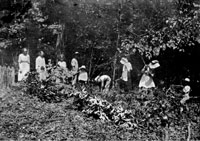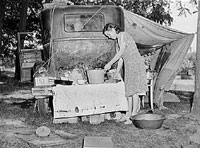|
|
|
Page 11 |
|
"Modernity" and U.S. farm women's poultry operations. Jane Adams,Southern Illinois University
|
|
|
 |
|
Farmers' economic instability corresponded to their increasing displacement from the ideological and political center of the nation's life: It expressed a real decline in both economic and (to use Bourdieu's terminology) symbolic capital. Farming communities, particularly in the North, also became more differentiated as some farmers and their children succeeded and others became tenants and laborers. (14)
Further, industrial production created ever more relatively inexpensive consumer goods, both utilitarian and symbolic. Women were major targets of these goods (see Ownby 1999, Blanke 2000). They were distributed through stores in town and by itinerant peddlers who often took farm produce, especially chickens, in exchange for goods. (15) In the late 19th century mail order houses like Montgomery Ward and Sears allowed even greater access to mass consumer markets. (16)
At the same time, cities were growing and changing form. In the towns and villages of the antebellum period most town lots included gardens, perhaps a small orchard, and poultry. Often families owned a cow or two and some pigs, as well as, in the more prosperous homes, horses. By the 1870s progressive reformers were able to get legislation passed in most towns that required livestock to be fenced (Adams 1992). By this time cities had become industrial workplaces and waves of immigrants had begun to arrive from Europe to work in these factories. (17) Tenements were built to accommodate them. Completely separated from any possibility of self-provisioning, these urban workers relied entirely on the market for their sustenance.
In this context, urban produce markets -- physical market places -- expanded. These markets sold directly to consumers and wholesaled to shops, restaurants, and peddlers who then retailed the goods. Some farmers regularly carried their horticultural and other products to the markets but most farmers, too distant from the towns and cities to easily travel to a weekly market, sold their goods to brokers who sold them on both wholesale and retail markets. Chickens and eggs entered these distribution networks. (18)
|
|
 |
|
|
|
"Modernity" and U.S. farm women's poultry operations: farm women nourish the industrializing cities 1880-1940. Paper presented at the international conference, The Chicken: Its Biological, Social, Cultural, and Industrial History: From Neolithic Middens to McNuggets. May 17-19, 2002, Yale University, Program in Agrarian Studies. © Jane Adams 2002
Jane Adams' Home Page
|
|
|
|
|
|
| Women and children clearing brush, Union County.Morris Library, Southern Illinois University at Carbondale. |
|
 |
|
|
Migrant berry pickers, Berrien Co, Michigan, 1937. Arthur Rothstein. FSA/OWI Library of Congress. |
|
|
|
|
|
|
|
|
|
|
|
|
|
|
|
|
|

